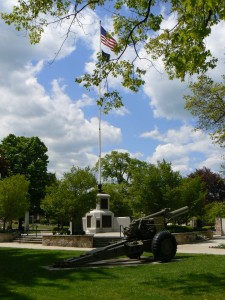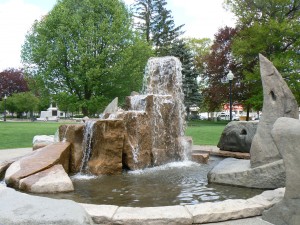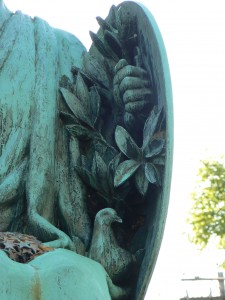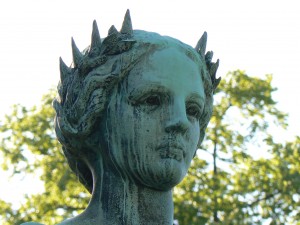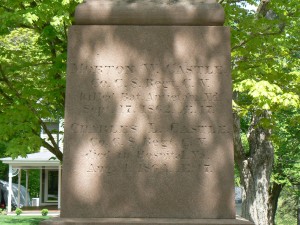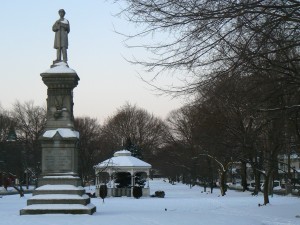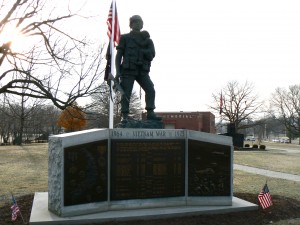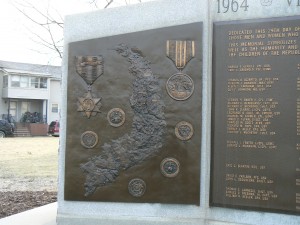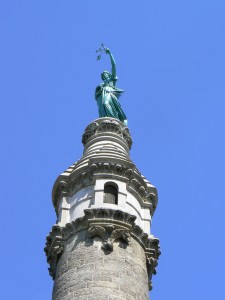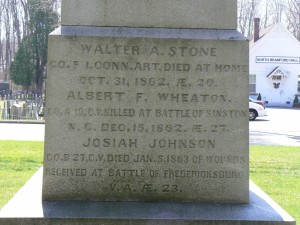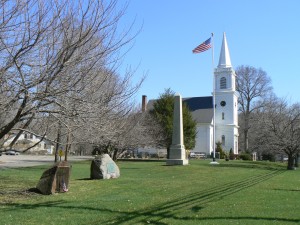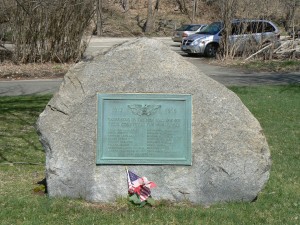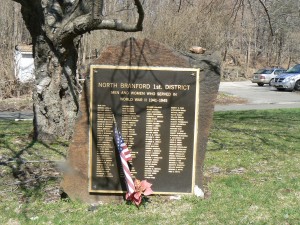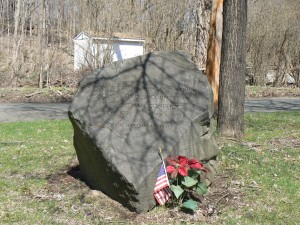 Several monuments honoring the wartime service of local residents grace Coe Memorial Park in downtown Torrington.
Several monuments honoring the wartime service of local residents grace Coe Memorial Park in downtown Torrington.
At the north end of the park, near the intersection of Main Street and Litchfield Turnpike, stands the Wolcottville Soldiers’ Monument, which reflects the name of the city during the monument’s dedication in 1879.
The monument, with an uncommon round shaft, features an infantry soldier holding a rifle. The front (north) face includes the Connecticut and United States shields above a dedication “to the defenders of the Union.” The monument’s rear lists the battles of Gettysburg and Antietam, as well as Virginia battles at Winchester, Malvern Hill, Cold Harbor, Petersburgh (sic) and Cedar Creek.
The monument was moved to the park from its former location, in front of city hall, in 1936.
Near the center of the park is a large flagpole with a six-sided base that honors veterans from conflicts including the two World Wars, the American Revolution, the Spanish-American War, Korea, Vietnam, and the Civil War. Veterans of the First World War are listed, while the other wars are honored with more generic descriptions. A plaque also singles out local Italian-American veterans for recognition.
 Near the flagpole monument, the local VFW post donated a 155-mm howitzer that looks impressive in the park. The barrel looks poised to cause serious damage to the rest of downtown Torrington.
Near the flagpole monument, the local VFW post donated a 155-mm howitzer that looks impressive in the park. The barrel looks poised to cause serious damage to the rest of downtown Torrington.
At the southern end of the park, a large stone fountain honors the service and sacrifice of local Vietnam veterans and heroes.
Coe Memorial Park was donated to the city in 1908 by the children of Lyman Wetmore Coe and his wife, Eliza Seymour Coe. Mr. Coe was the owner of a local brass company, and the park was the site of their homestead.
Source:
Connecticut Historical Society: Civil War Monuments of Connecticut
Tags: Torrington
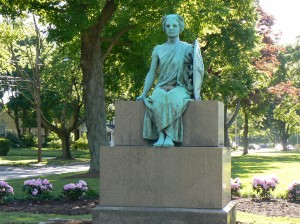 A war memorial featuring a female allegorical figure representing patriotism and peace stands on a green near the corners of West Broad and Main Street in Stratford.
A war memorial featuring a female allegorical figure representing patriotism and peace stands on a green near the corners of West Broad and Main Street in Stratford.
The monument, at the east end of the West Broad Street Green, was dedicated in 1931 as a memorial to peace intended to honor the local men and women who served in the country’s wars, including the first World War (during which 630 residents served and 13 lost their lives).
The monument’s sculptor, Willard Paddock, was a Kent resident who was charged by the committee to create a monument to peace.
Paddock’s monument depicts a seated figure holding a large shield, decorated with stars and an eagle, in her left arm. The shield is protecting a dove, which symbolizes peace. Her lap is decorated with oak leaves and stars symbolizing local residents lost in combat.
 Her right hand once held a sword, which was reportedly removed after the monument’s completion because some felt it was not in keeping with the monument’s peace theme. The hilt of the former sword is still visible.
Her right hand once held a sword, which was reportedly removed after the monument’s completion because some felt it was not in keeping with the monument’s peace theme. The hilt of the former sword is still visible.
The monument was dedicated on May 24, 1931, in ceremonies attended by Governor Wilbur Cross (for whom the state would later name a parkway).
Source:
In Pursuit of Paradise: a History of Stratford, CT by Lewis G. Knapp, 1989, Stratford Historical Society
Tags: Stratford
 The town of Orange honors local veterans with memorials in two locations.
The town of Orange honors local veterans with memorials in two locations.
At the High Plains Community Center, the town dedicated a Remembrance Walk display in 2005. Local families purchased bricks honoring the service of veterans in a variety of wars dating back to the American Revolution.
A plaque on the largest of the three flagpoles at the site bears the emblems of five service branches as well as a quote from President John F. Kennedy: “The cost of freedom is always high but Americans have always paid it. And one path we shall never choose is the price of surrender or submission.”
The Remembrance Walk also features several granite benches as well as decorative shrubbery.
 Not far from the Remembrance Walk, a boulder on the town green bears a plaque dedicated by the local American Legion post in memory of veterans of the country’s major wars between the American Revolution and Vietnam.
Not far from the Remembrance Walk, a boulder on the town green bears a plaque dedicated by the local American Legion post in memory of veterans of the country’s major wars between the American Revolution and Vietnam.
A nearby engraved boulder monument honors the local volunteer fire department.
Orange’s Civil War veterans are also honored on the Soldiers’ and Sailors’ Monument in West Haven’s Oak Grove Cemetery, which was in Orange when the monument was dedicated in 1890. (West Haven was split off from Orange in 1921.)
Tags: Orange
 A brownstone obelisk erected in the village of Northfield in 1866 was one of the state’s earliest Civil War monuments.
A brownstone obelisk erected in the village of Northfield in 1866 was one of the state’s earliest Civil War monuments.
The monument stands on the village green in the Northfield section of Litchfield. The south face (the front) bears the dedication “That the generations to come might know them,” “Lincoln” in raised letters, and the names of three local men who died in the war. Two were killed at the Battle of Winchester, Va., in 1864, and the other died at the Battle of Fishers Hill, Va., in 1864.
The east face of the monument lists two names – a hospital death at Alexandria, Va., in 1863 and a battle death from Cold Harbor, Va., in 1864.
The north face records two deaths – one from the 1863 battle at Chancellorsville, Va., and the other at the Cold Harbor battle.
 The west face records a death at the Battle of Antietam, Md., in 1862, as well as a death in an unspecified Virginia hospital in 1864.
The west face records a death at the Battle of Antietam, Md., in 1862, as well as a death in an unspecified Virginia hospital in 1864.
The ages of the nine men listed on the monument range from 17 to 37, with most of the deaths coming when the men were in their late teens to early 20s.
A decorative urn, as well as a carved sculpture depicting an eternal flame, stands atop the monument’s shaft.
Source:
Connecticut Historical Society: Civil War Monuments of Connecticut
Tags: Northfield
 A black granite slab mounted outside the town’s police department honors Woodbridge’s veterans.
A black granite slab mounted outside the town’s police department honors Woodbridge’s veterans.
The monument, dedicated in 1994 by Woodbridge’s Lt. G. Bronson Bedworth Post of the Veterans of Foreign Wars, bears the inscription “In everlasting tribute to the men and women of Woodbridge who have served their nation with honor to preserve freedom.”
The polished granite slab is topped by a gold-colored eagle, and has medallions representing the various military service branches mounted on separate slabs. Two granite-topped benches, a flagpole and a variety of ornamental shrubs complete the monument site, outside the police station on Meetinghouse Lane.
 A small boulder on Racebrook Road, slightly north of the intersection with Ansonia Road, marks the former homestead of American Revolution veteran Samuel Baldwin, who was killed in present-day West Haven during the 1779 British attack on New Haven. The boulder features a bronze plaque listing the dates of Mr. Baldwin’s birth and date, and explaining the monument’s location at his former home.
A small boulder on Racebrook Road, slightly north of the intersection with Ansonia Road, marks the former homestead of American Revolution veteran Samuel Baldwin, who was killed in present-day West Haven during the 1779 British attack on New Haven. The boulder features a bronze plaque listing the dates of Mr. Baldwin’s birth and date, and explaining the monument’s location at his former home.
Tags: Woodbridge
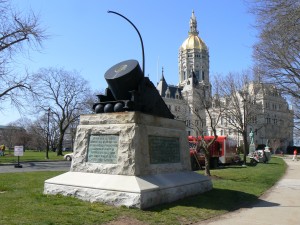 A 13-inch mortar used in the Civil War was mounted on the grounds of the state capitol in 1902.
A 13-inch mortar used in the Civil War was mounted on the grounds of the state capitol in 1902.
The mortar, nicknamed the “Petersburg Express” and “the Dictator,” was used in the siege of Petersburg (Va.), a series of trench-fighting skirmishes near Petersburg and Richmond in 1864 and 1865.
The monument was erected in 1902 to honor the service of the 1st Conn. Heavy Artillery unit, which was formed in 1861 and served in the defense of Washington and several engagements in Virginia before the siege of Petersburg.
The mortar has been mounted near the intersection of Capitol Ave. and Trinity Place on a granite base. The south face bears a plaque reading “This 13-inch sea coast mortar was in actual use by the regiment during the campaign in front of Petersburg 1864-1865 and widely known as the ‘Petersburg Express.’”
 The west face has a plaque listing the regiment’s service dates, and the east face has information about the monument’s dedication. The north face bears a bronze Connecticut seal.
The west face has a plaque listing the regiment’s service dates, and the east face has information about the monument’s dedication. The north face bears a bronze Connecticut seal.
During the war, the mortar fired 225-pound cannonballs and was mounted on a railroad car for portability. The squat design and thick walls were designed to accommodate the explosion of the 20 pounds of gunpowder used when the mortar was fired.
The black-and-white image of the Dictator is courtesy of the Library of Congress’ American Memory project. We’re not positive it depicts the mortar now mounted in Hartford, but there’s a decent chance that it does.
Sources:
Library of Congress, Prints & Photographs Division, LC-DIG-cwpb-03851 DLC
Connecticut Historical Society: Civil War Monuments of Connecticut
Wikipedia: Siege of Petersburg
Tags: Hartford
 The first time we highlighted the 1888 Soldiers’ and Sailors’ Monument on Milford’s green, it was early February and southern Connecticut was covered with what appeared at the time to be perpetual snow cover. Now that winter has gradually faded into spring, we noticed the impressive collection of flowers surrounding the base of the monument and, given a brief break from the rains of the past week or so, decided the monument warranted another post.
The first time we highlighted the 1888 Soldiers’ and Sailors’ Monument on Milford’s green, it was early February and southern Connecticut was covered with what appeared at the time to be perpetual snow cover. Now that winter has gradually faded into spring, we noticed the impressive collection of flowers surrounding the base of the monument and, given a brief break from the rains of the past week or so, decided the monument warranted another post.
The monument sits at the center of a round planting bed that features an outer ring of what we believe to be in the hyacinth family (we’re somewhat embarrassed to admit that we know so little about plants that our first two guesses at how to spell “hyacinth” stumped Google, and we eventually had to search for “purple flowers”) along with several rows of white, purple and red tulips (those we know).
 As we mentioned in February (the bottom image is from that post), the monument was dedicated in 1888 to honor the service of local Civil War veterans in battles including Gettysburg, Fort Fisher (N.C.), Port Hudson (La.) and Appomattox.
As we mentioned in February (the bottom image is from that post), the monument was dedicated in 1888 to honor the service of local Civil War veterans in battles including Gettysburg, Fort Fisher (N.C.), Port Hudson (La.) and Appomattox.
Tags: Milford
 A collection of monuments near the War Memorial community center and gym in Danbury honor the service and sacrifice of local veterans and war heroes.
A collection of monuments near the War Memorial community center and gym in Danbury honor the service and sacrifice of local veterans and war heroes.
The War Memorial, built in 1951 near the entrance to Rogers Park, was dedicated “to honor the dead [and] to serve the living.” The facility offers recreational facilities and community events, and the grounds in front of the building feature memorials to the World Wars, Vietnam and Korea, and honor two local recipients of the Medal of Honor.
Near the War Memorial entrance are five plaques honoring those who served in the major wars since World War I. Starting at the visitor’s left, the first plaque bears the dedication “In honor of the men and women of Danbury who served in World War II 1941-1945 The memory of these departed heroes always lives,” and lists the names of 103 residents lost in the war.
 The next monument to the right lists a dozen names of people from Danbury and surrounding towns who died in the Korean War.
The next monument to the right lists a dozen names of people from Danbury and surrounding towns who died in the Korean War.
In the center of the monument collection is a plaque dedicated “In honor of the men and women of Danbury who served in the World War 1917-1919 And in memory of these men who made the supreme sacrifice for liberty.” The plaque lists the names, service affiliation, and the date and location of death, of 35 men.
The nearby Vietnam memorial lists the names of 59 men from Danbury and other towns who were killed or reported missing in the war.
The monument on the visitor’s far right also honors World War I veterans, and was erected by the Danbury High School alumni association to honor graduates who served in the war. Four columns of names are listed, and three graduates who died in the war are honored separately on the plaque (as well as on the other World War I memorial).
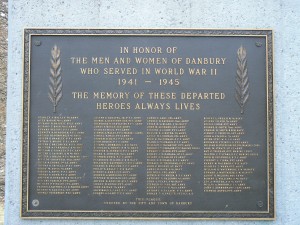 Near the north end of the grounds in front of the War Memorial is a 1988 monument honoring the service of men and women from the region in the Vietnam War. The monument is topped by a statue of an infantry soldier cradling a young girl. The soldier is mounted on a granite base with three bronze plaques.
Near the north end of the grounds in front of the War Memorial is a 1988 monument honoring the service of men and women from the region in the Vietnam War. The monument is topped by a statue of an infantry soldier cradling a young girl. The soldier is mounted on a granite base with three bronze plaques.
The central plaque lists the names of 47 men from Danbury and the towns of Bethel, Brookfield, New Fairfield, New Milford, Newtown, Redding and Ridgefield who were lost in the conflict. The plaque on the left depicts a map of Vietnam and service medals, and the right plaque depicts a medical evacuation scene.
We were impressed at the gesture made by Danbury veterans to honor their colleagues from neighboring towns on the Vietnam and Korea monuments.
 A bit south of the Vietnam memorial is a polished black granite monument to the sacrifice of 17 men from the region who were killed in the Korean War. The monument is topped by an eagle standing on top of a globe. The central panel features an etched map of Korea and a dedication to those who died, are missing or returned safely. (These photos were taken in mid-March, which helps explain the holiday wreath at the base of this monument.)
A bit south of the Vietnam memorial is a polished black granite monument to the sacrifice of 17 men from the region who were killed in the Korean War. The monument is topped by an eagle standing on top of a globe. The central panel features an etched map of Korea and a dedication to those who died, are missing or returned safely. (These photos were taken in mid-March, which helps explain the holiday wreath at the base of this monument.)
The left panel honors the memory of war heroes from Danbury, New Fairfield, New Milford, Bethel, Redding and Newtown, and the right panel has an explanation and statistics that educate visitors about the war.
Two smaller nearby monuments honor local heroes who have been awarded the Congressional Medal of Honor, and several trees commemorate the Sept. 11 victims and local residents who have made a variety of civic contributions to Danbury.
Tags: Danbury
 The 110-foot tall Soldiers’ and Sailors’ Monument high above New Haven is visible for miles on a clear day.
The 110-foot tall Soldiers’ and Sailors’ Monument high above New Haven is visible for miles on a clear day.
The monument, at the summit of East Rock Park, was dedicated in 1887 to honor soldiers and sailors who fought in the American Revolution, the War of 1812, the Mexican-American War and the Civil War.
The monument features a round granite column rising from a square base with allegorical bronze statues on all four corners, and bas relief sculptures depicting scenes from the highlighted wars.
The monument is topped by an 11-foot tall statue known as the Angel of Peace, which faces downtown New Haven and holds an olive branch in an outstretched left arm. The statue, originally installed in March 1887, was restored in 2006 and returned to the top of the monument.
Four allegorical statues appear on the corners of the monument’s base. The west corner depicts History holding a book, and the south corner symbolizes Patriotism holding a sword. The east corner represents Victory, and the north corner depicts Prosperity.
 The front (southwest) face of the monument honors the Civil War, and lists the battlefields of Gettysburg, Port Hudson (La.) and Fort Fisher (N.C.). A scene on the southwest face depicts Robert E. Lee’s surrender of the Army of Northern Virginia at Appomattox Court House, Va. in April of 1865. In this scene, Lee appears to have a painful headache, which, under the circumstances, is probably understandable.
The front (southwest) face of the monument honors the Civil War, and lists the battlefields of Gettysburg, Port Hudson (La.) and Fort Fisher (N.C.). A scene on the southwest face depicts Robert E. Lee’s surrender of the Army of Northern Virginia at Appomattox Court House, Va. in April of 1865. In this scene, Lee appears to have a painful headache, which, under the circumstances, is probably understandable.
The southwest face also has a door to the interior of the monument that has been boarded over, probably because the interior staircase to the upper-level viewing area has reportedly fallen into disrepair.
Moving to the right, the southeast face of the monument honors the American Revolution by listing the battlefields of Bunker Hill (outside Boston), Bennington (Vt.) and Saratoga (N.Y.) below a scene depicting the British surrender at Yorktown.
 The southeast face also bears one of two large bronze plaques with 520 names of soldiers and sailors from New Haven who died in the Civil War. The plaques, which were added to the monument in 1894, have ornate decorative borders with raised moldings and ribbons that feature regimental emblems and the names of Civil War battlefields.
The southeast face also bears one of two large bronze plaques with 520 names of soldiers and sailors from New Haven who died in the Civil War. The plaques, which were added to the monument in 1894, have ornate decorative borders with raised moldings and ribbons that feature regimental emblems and the names of Civil War battlefields.
The plaque on the northwest face is substantially darker than the plaque on the southeast face, and along with the scenes on this and the northeast face, could use a good cleaning.
The northeast (rear) face of the monument honors the War of 1812 by listing battlefields near Lake Erie, Lake Champlain and New Orleans and a hard-to-discern naval scene. The rear face has a doorway that is either false or has been cemented over.
 The northwest face honors the 1846 Mexican-American War by listing battlefields near Palo Alto (near Brownsville, Texas), Molino Del Rey and Chapultepec. A scene from that war appears above a second plaque listing local Civil War heroes.
The northwest face honors the 1846 Mexican-American War by listing battlefields near Palo Alto (near Brownsville, Texas), Molino Del Rey and Chapultepec. A scene from that war appears above a second plaque listing local Civil War heroes.
According to the Connecticut Historical Society, the monument’s dedication in June of 1887 was attended by Union generals William Tecumseh Sherman and Philip Henry Sheridan. A parade of 20,000 people was watched by a crowd estimated at more than 100,000.
The plaques listed the Civil War dead were added seven years later.
As you can see from the vintage postcards appearing below, the monument’s surroundings have changed over the years. In the first postcard, a small pavilion that stood at the summit appears neat the center of the image. The pavilion is gone, as is the cannon the gentleman appears to be sitting on, but the pavilion’s foundation remains.
Over the years, a small plaza and fence have been added to the monument’s base, probably to discourage vandalism or theft of the bronze plaques.
The vertical postcard with the small trees in the foreground was mailed in 1954 from New Haven to Cleveland.
 The postcard depicting the cliff under the monument was postmarked in 1910, and mailed from New Haven to Dwight, Mass.
The postcard depicting the cliff under the monument was postmarked in 1910, and mailed from New Haven to Dwight, Mass.
The final image in this post is a panorama shot taken from the parking area in front of the monument, looking south toward New Haven harbor, downtown New Haven and the West Haven shoreline.
Source:
Connecticut Historical Society: Civil War Monuments of Connecticut
Tags: New Haven
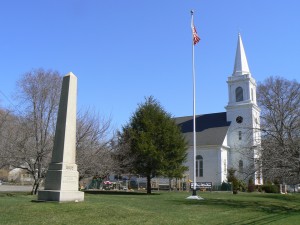 An 1866 obelisk on the North Branford town green was among the first monuments in the state to honor Civil War veterans.
An 1866 obelisk on the North Branford town green was among the first monuments in the state to honor Civil War veterans.
The monument stands on the green along Foxon Road (Route 80), next to the Congregational Church, and was dedicated in April of 1866 — less than a year after the war’s conclusion. The monument a bears simple inscription on its front (southeast) face reading “Our soldiers” and the year 1865.
The northeast face of the monument lists the names, unit affiliations and places of death of two local soldiers killed in the war. The northwest face lists three soldiers and the southwest face honors two soldiers.
The Civil War monument is one in a series of monuments aligned along the town green. Moving south, the next monument is a boulder with a bronze plaque that honors World War I veterans. The plaque bears the dedication “to the men who served their country during the World War” and lists 17 names.
 Next to that monument is another stone monument with a plaque, apparently of recent vintage, with four columns of names honoring veterans of World War II. A separate monument, further south, honors six local residents who were killed in the war.
Next to that monument is another stone monument with a plaque, apparently of recent vintage, with four columns of names honoring veterans of World War II. A separate monument, further south, honors six local residents who were killed in the war.
Completing the monument collection on the green is a rough boulder at the southern end that is dedicated to those who served in the Vietnam War.
Sources:
Connecticut Historical Society: Civil War Monuments of Connecticut
Tags: North Branford
